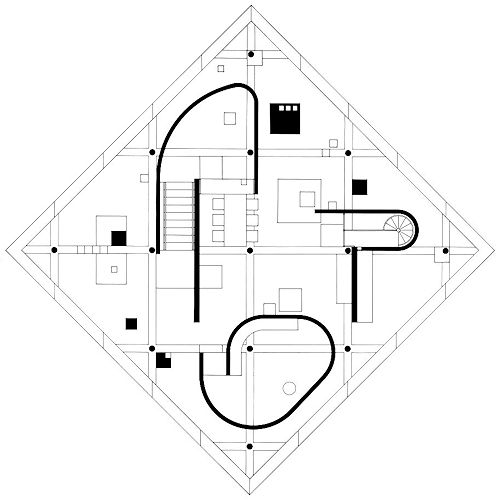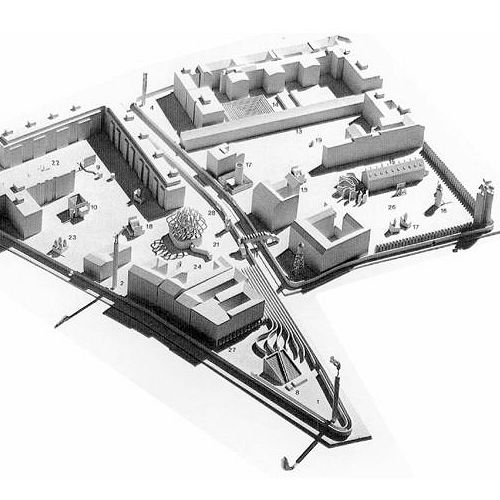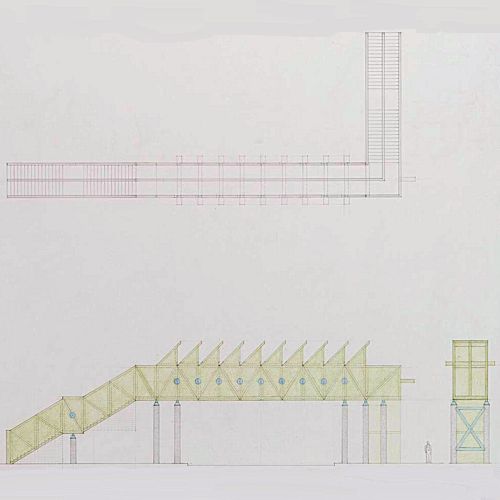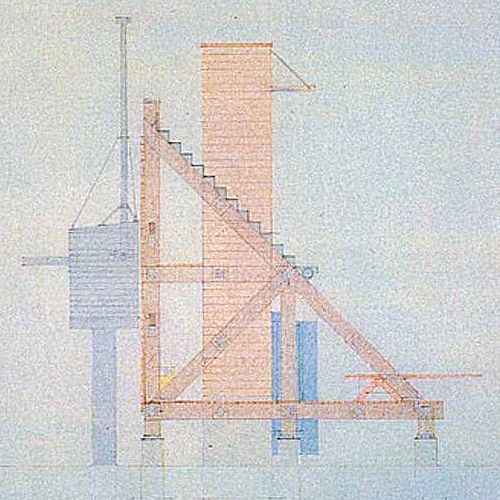These sixty-odd works might be among the most beautiful architectural drawings ever made, subtle arrangements of hues--limpid yellows, ochres, greens, and blues--accenting masterly pencil lines. But they are also products of an idiosyncratic vision of architecture, one that is both speculative, reflecting on its underlying nature, and critical, primed by absences within contemporary terrain. They specifically address the notion of the “program,” the relation between building and user, or space and action, long repressed under formal concerns.
Reflection on the relation between architecture and the activities occurring within it inevitably involves meditation on the nature of society, something that architecture’s current irrelevance to social and imaginative needs has only recently revealed by default. This exhibition, conceived as a 35-year ellipse, indicates this “narrative” interest as Hejduk’s abiding concern; it is evident from the early illustrations for Aesop’s Fables, 1947, which adumbrate the allegorical focus in contemporary art, to the most recent ceremonial “Masques.” Hence it is possible to see the 1967 Diamond House Project, a hallmark in “formal” architectural thought, as a kind of performance space in which the different functions arranged throughout the open plan lead the actor up, down, around, and through in a carefully staged sensuous trajectory. Projects like the Devil’s Bridge, 1981, and the series of masques patterned on theatrical processionals extend these implications; they are both tales, developing imaginary events, and allegorical structures, architectural narratives.
The Retreat House, 1980, for example, is a “rural Masque” designed for a single inhabitant—a spare wooden structure located on plains by hill and sea and furnished with minimal utilities. But these utilities are not casually aligned. With the kind of “objective” focus common to Alain Robbe-Grillet and Jean Baudrillard, Hejduk has placed them according to “anticipated function”: much as chair faces diving board, so bed faces desk, and so on. Thus the architectural structure is not regulated by simple functions but by poetically determined activities, by relations of events which lead the solitary inhabitant through the encompassing spaces in a ritualistic procession. Moreover, the notion of the masque also implies another dimension: just as mask covers mummer, allowing him or her to enact the given festivities, so architecture’s vocabulary of walls, floors, and other “formal” divisions covers, or masks, existential coordinates. Hence the role of the ritual: it is only through the processional, the “narrative” movement through space and all its constellating objects, that these radicular relations are revealed.
The value of the tale in revealing these underlying profundities has been noted by modern writers, of whom Italo Calvino (The Invisible Cities) is only one. And that such allegorical statements might be applied to urban planning is evident from the Berlin Masque, 1981, Hejduk’s prize-winning entry in the International Building Exposition Bauausstellung Competition for the reconstruction of Berlin. In the manner of allegorists, appeal is made to a precedent, recuperating it for the present period: “. . . as it was necessary for the highly rational-pragmatic city of 15th-century Venice to create masques . . . for its time in order to function,” we are told in one of the exhibited notes, “it would appear that we of our time must create masques (programs????) for our times.” The twenty-odd drawings surrounding the pristine model are precise 3/16-inch scale renderings of a poetic conception easily translated into physical form; just as the masque is meant for the people of Berlin, so it is designed for a specific site located near the Wall. Each of the 28 elements is multiply conceived. A narrow steel watch tower functions as an observatory, allowing the solitary observer to survey the surround, but it also serves as a metaphysical tool, aligning one existentially. A clocktower, with its metal gnomon moving from 12 up to 12, down to 12 and on, presents a “double” way of seeing time. Bookstalls, a lottery woman, an arbitration hall, a pantomime theater, and a maze are among the different elements arranged within the site, which, in their interrelations, suggest the reticulations of the modern city. And throughout the drawings are figures who do not, as in the current architectural manner, play a decorative role, but provide necessary references to the sturdy Berliner citizens who perform the activities or masques. Hejduk writes in the notes that he has conceived the masque as a “serious carnival” related to the existential condition of the city. The poems, texts, and literary references scattered amidst drawings on the walls indicate that poets grasp the psychic dimensions of these evocative spaces intuitively.
| |


| |


|



